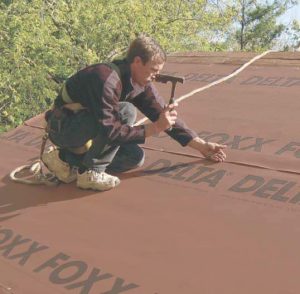Building Energy Efficient in Alaska
We at Saturn are pleased to announce a new project with the Alaska Craftsman Home Program (ACHP) to republish their excellent new-construction manual, Northern Comfort. Northern Comfort is all about building heavily insulated homes in Alaska. In Alaska’s climates, you need a lot of insulation and an airtight building shell to provide comfort and energy efficiency to new-home buyers.
Of course, thermal comfort and efficiency aren’t all we need for exemplary new homes. Health and safety are vital priorities and our focus on energy efficiency and thermal comfort must also deliver Alaskans healthy and safe homes. Durability is another important priority to protect and preserve the precious natural resources that we put into these energy-efficient new homes we’re building. Rain and the vapor pressure cause a lot of moisture damage in Alaska

Waterproof and vapor permeable, this roof underlayment transmits over 500 perms making it much more vapor permeable than house wrap.
Alaska has a variety of cold climates from Ketchican to Nome. To simplify our climate considerations, we may divide Alaska into two climate zones that we’ll call Rainy Alaska and Non-Rainy Alaska. The division point would be around 40 inches of annual precipitation.
Barriers and Retarders: Many Products
The thorniest issues we encounter are the barriers and retarders. I don’t know that many architects and builders comprehend and use the concepts of Type I, II, and III vapor retarders. How to use those concepts really has me scratching my head right now. I’m learning a lot about building products and techniques for energy efficient homes that I’ll be sharing through this blog.
Today I’m researching water-proof and water-vapor permeable roof underlayments. With cathedral ceilings, you really need to protect the sheathing from moisture especially if it is oriented-strand board (OSB). Many builders are spraying polyurethane foam on the underside of the warm-attic roof sheathing in response to the International Residential Code’s instruction to install a air-impermeable insulation. For Alaska we’ll recommend always venting the top 1.5 inches of the cathedral cavity or the open cavity of the warm attic. Another protection option is the vapor permeable roof underlayment. Quality builders use these types of underlayments under metal and masonry roofs, but they also work well under asphalt shingles. The perm ratings of these products vary from 50 to 500 perms! Seems like you could make a roof last 100 years if the sheathing can stay dry and the shingles sit on a watertight underlayment.

Another useful post for Everyone. I want more information about new construction.